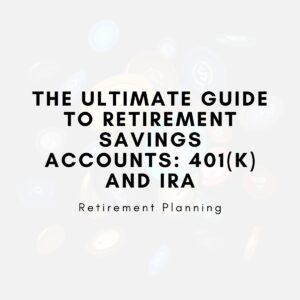
How much money do you need to retire comfortably?
The answer depends on various factors, including your lifestyle goals, healthcare expenses, and the age you plan to retire. A good starting point is using the 4% rule, which suggests saving 25 times your desired annual retirement income. For example, if you aim for $50,000 per year, you need at least $1.25 million. However, this amount can vary based on inflation, medical costs, and how long you expect to live. In this guide, we’ll provide you with practical steps to calculate your retirement needs and show how you can create a customized retirement plan.
Summary Table: How Much Money Do You Need to Retire Comfortably?
| Section | Summary | Key Tips | Examples |
|---|---|---|---|
| Introduction | This section explains the importance of retirement planning and introduces the question of how much money is needed to retire comfortably. | Start planning early; understand your retirement goals, lifestyle, and expenses. | Alex begins planning for retirement at 30 by saving 15% of his income annually. |
| Understanding Retirement Goals | Retirement goals vary depending on lifestyle, family needs, and desired activities. It’s important to tailor your savings to your specific goals. | Set realistic retirement goals based on desired lifestyle and expected expenses. | Sarah aims to retire at 60 with a focus on travel, estimating she’ll need $1.5 million in savings. |
| The 80% Rule: Estimating Retirement Income | The 80% Rule suggests that you’ll need 80% of your pre-retirement income annually to maintain your current lifestyle. | Use the 80% Rule as a starting point, adjusting for lifestyle changes. | Tom earns $80,000 annually. Based on the 80% Rule, he will need $64,000 per year in retirement. |
| The Impact of Inflation | Inflation reduces purchasing power over time, which is why you need to account for it when planning retirement. | Consider a 2-3% inflation rate annually when calculating retirement expenses. | Jane estimates that inflation will increase her retirement expenses by 2.5% annually, requiring an additional $200,000 over 30 years. |
| The Role of Social Security | Social Security may provide a portion of your retirement income, but it shouldn’t be the sole source of funding. | Factor in Social Security benefits, but don’t rely on them for the majority of retirement income. | Roger expects to receive $1,800 per month from Social Security, but plans to save $30,000 per year in addition to cover the rest of his retirement needs. |
| The 4% Withdrawal Rule | The 4% Rule suggests you can safely withdraw 4% of your retirement savings each year without running out of money. | Calculate your retirement nest egg by multiplying your desired annual income by 25 (the inverse of 4%). | Anna wants $60,000 in annual retirement income. Based on the 4% rule, she will need $1.5 million ($60,000 x 25) saved by the time she retires. |
| The Importance of Retirement Accounts: 401(k) and IRAs | 401(k)s and IRAs offer tax advantages and should be prioritized for retirement savings. Contributions can grow tax-deferred or tax-free. | Contribute enough to your 401(k) to receive the employer match; consider IRAs for tax-advantaged growth. | David contributes $10,000 to his 401(k) and $6,000 to his Roth IRA, resulting in a total contribution of $16,000 per year. Rebecca contributes $6,000 annually to her 401(k), which grows over time with her 7% annual return rate. |
| Real-Life Examples and Calculations | Real-life examples of retirement savings calculations and how different strategies can affect total retirement savings. | Regular contributions, compound interest, and diversifying retirement accounts are key to long-term success. | Rebecca invests $6,000 annually into her 401(k), with a 7% return rate, resulting in $500,000 by age 65. Brian contributes $5,000 to his Roth IRA, with $450,000 expected at retirement. |
| How to Calculate Your Retirement Needs? | Step-by-step guidance on calculating the amount needed for retirement based on desired lifestyle, expenses, and income sources. | Create a detailed budget for retirement; use tools like retirement calculators and work with financial advisors. | Megan uses a retirement calculator and adjusts her savings rate, factoring in estimated inflation and expenses. She aims to save $1.2 million by retirement. |
| Conclusion | Summarizes the key takeaways from the post and reinforces the importance of early, consistent saving for retirement. | Start saving early, stay disciplined, and review your retirement goals periodically. | Paul started saving for retirement at age 25 and has consistently saved $12,000 per year, helping him stay on track to retire comfortably with over $1 million saved by age 65. |
This table provides a comprehensive summary of the post, focusing on essential strategies and key considerations for determining how much money you need to retire comfortably. The inclusion of real-life examples helps illustrate how various retirement tools, such as the 80% Rule, inflation adjustments, Social Security, and retirement accounts like 401(k)s and IRAs, can be effectively applied to personal financial planning. By understanding these concepts and implementing the tips provided, you can make more informed decisions about your retirement savings and work towards a secure financial future.
Introduction
One of the most common questions you might ask as you approach retirement is: How much money do I need to retire comfortably? While it might seem like a straightforward question, there’s no one-size-fits-all answer. Your retirement savings depend on various factors like your current expenses, desired lifestyle, healthcare costs, and even inflation.
This guide will walk you through the critical steps to calculate your retirement needs, offer strategies to reach your financial goals, and present actionable advice with real-life examples. Whether you’re just starting to plan for retirement or are already thinking about how much money you’ll need, this post is designed to provide clarity.
How to Determine Your Retirement Expenses?
The first step in understanding how much money you need to retire comfortably is to calculate your retirement expenses. These are the costs you will incur once you stop working. While it may seem easy to estimate, the reality is that retirement expenses are often more complex.
What Will Your Lifestyle Be Like in Retirement?
Your lifestyle decisions will directly affect how much you need to save. Will you travel the world, downsize your home, or stay put? Your living situation and activities will have a major impact on your retirement budget.
Example:
Anna, a 45-year-old lawyer, plans to retire at 65. She wants to live in a small apartment, travel to different countries, and engage in local hobbies. After estimating her monthly living costs at $3,000, her annual expenses will be around $36,000. However, with travel and activities, her projected annual retirement budget is around $60,000.
Breakdown of Typical Retirement Expenses
Healthcare and Insurance Costs
Healthcare is a significant expense for retirees, especially as you age. Medicare only covers a portion of healthcare costs, and you might still need supplemental insurance or out-of-pocket funds.
Example:
John, who plans to retire at 62, estimates healthcare costs at $5,000 annually. However, he expects these costs to rise as he gets older. By 75, his healthcare expenses may reach $10,000 annually, considering inflation.
Housing Costs in Retirement
Whether you plan to stay in your current home or downsize, housing will take up a significant portion of your budget. Consider your mortgage, rent, property taxes, and upkeep.
Example:
Linda plans to sell her large family home at 65 and move to a condo. She estimates the new property will cost $1,200 per month to maintain. In addition, her property taxes will be about $3,000 per year.
The 4% Rule: A Foundation for Retirement Savings
One of the most commonly used strategies to determine how much money you’ll need for retirement is the 4% rule. This rule of thumb suggests that you can safely withdraw 4% of your savings each year without running out of money.
Understanding the 4% Rule
The 4% rule is based on the premise that your investments will grow at a rate that outpaces inflation. The idea is that if you save 25 times your desired annual income, you can withdraw 4% each year and fund your lifestyle.
Example:
Robert wants to retire at 60 and plans to live on $40,000 annually. By applying the 4% rule, he multiplies $40,000 by 25.
$40,000 x 25 = $1,000,000
This means Robert would need $1 million saved up by retirement to withdraw $40,000 per year for 30 years.
How to Adjust the 4% Rule for Your Goals?
While the 4% rule is a good baseline, it’s important to customize it based on your own goals. For instance, if you expect to live longer or need a higher income due to inflation, you may need to aim for a 3.5% or even 3% withdrawal rate.
Example:
Sarah, a 50-year-old nurse, wants to retire at 60 and desires $60,000 per year in retirement income. She calculates that she will need $1.5 million based on the 4% rule. However, she decides to lower her withdrawal rate to 3.5% because of her concern about living longer.
Accounting for Inflation in Retirement
Inflation is a crucial consideration when calculating how much money you need for retirement. Over the course of 20-30 years, inflation can significantly erode the purchasing power of your savings.
Why Inflation Matters?
At an average rate of 3%, prices double approximately every 24 years. This means that the money you need today will likely not be sufficient in the future.
Example:
Tom, who is 40, wants $50,000 annually in retirement. He calculates that inflation at 3% will increase his desired retirement income to $120,000 annually by the time he reaches 70. To prepare, he increases his target savings goal.
Inflation-Adjusted Investments
Investing in stocks, bonds, or real estate can help you outpace inflation. By choosing assets that historically deliver returns higher than inflation, you can ensure your retirement savings grow over time.
The Importance of Retirement Accounts: 401(k) and IRAs
When it comes to saving for retirement, choosing the right retirement accounts is as crucial as determining how much money you need to retire comfortably. Accounts like 401(k)s and Individual Retirement Accounts (IRAs) offer distinct advantages, from tax benefits to employer contributions, and can significantly impact the growth of your retirement savings.
What Is a 401(k) and Why Is It Important?
A 401(k) is an employer-sponsored retirement savings plan that allows you to contribute a portion of your pre-tax income. These contributions grow tax-deferred, meaning you don’t pay taxes on the money until you withdraw it in retirement. Additionally, many employers offer a matching contribution, which means they contribute a percentage of your salary to your 401(k), often up to a certain limit.
Example:
Emily, a 28-year-old marketing manager, contributes 10% of her salary to her 401(k), which is $6,000 per year. Her employer matches 50% of her contributions up to $3,000, bringing her total annual contribution to $9,000. Over the next 30 years, assuming an average return of 7%, Emily’s 401(k) will grow to over $750,000 just from her contributions, without factoring in salary increases or additional investments.
Maximizing Your 401(k): Key Strategies
To make the most out of your 401(k), it’s important to take full advantage of employer matching, contribute regularly, and try to reach the annual contribution limits. As of 2025, the IRS allows individuals to contribute up to $22,500 per year, with a catch-up contribution of $7,500 if you are 50 or older.
Employer Matching: Don’t Leave Free Money on the Table
If your employer offers a match, ensure you’re contributing at least enough to get the full match. Missing out on employer contributions is like turning down free money. For example, if your employer matches up to 4%, you should aim to contribute at least 4% of your salary to take full advantage of this benefit.
Example:
James, a 40-year-old software engineer, earns $100,000 annually. His employer offers a 100% match on the first 4% of his salary. By contributing $4,000 per year, James essentially gets an extra $4,000 from his employer, doubling his contribution for the year.
Contributions and Investment Options
Most 401(k) plans offer a range of investment options, such as mutual funds, target-date funds, and index funds. You can diversify your portfolio to balance risk and reward based on your age, risk tolerance, and retirement goals. The earlier you start contributing, the more time your investments have to grow, thanks to compound interest.
Example:
Sophia started contributing $5,000 annually to her 401(k) at age 25. By the time she’s 65, assuming an average annual return of 7%, her savings will grow to over $450,000, even without increasing her contributions. The power of compound interest over 40 years is a crucial factor in growing retirement savings.
What Is an IRA and Why Should You Consider One?
An Individual Retirement Account (IRA) is another type of retirement account that offers tax advantages. Unlike a 401(k), IRAs are not employer-sponsored, and you can open an IRA through a financial institution like a bank, credit union, or brokerage firm. There are two main types of IRAs: Traditional IRAs and Roth IRAs.
Traditional IRA: Tax-Deferred Growth
A Traditional IRA allows you to contribute pre-tax income, which lowers your taxable income for the year you make the contribution. Your investments grow tax-deferred, meaning you pay taxes only when you withdraw the funds during retirement.
Example:
Mark, a 45-year-old teacher, contributes $6,000 annually to his Traditional IRA. By doing so, he reduces his taxable income for the year by $6,000. Over time, his savings grow tax-deferred, and when he withdraws the funds at age 65, he will pay taxes based on his income tax bracket at that time.
Roth IRA: Tax-Free Growth
A Roth IRA, on the other hand, is funded with after-tax dollars. While you don’t get an immediate tax break, your money grows tax-free, and you won’t have to pay taxes on withdrawals in retirement. This makes Roth IRAs especially appealing if you expect to be in a higher tax bracket when you retire.
Example:
Lily, a 30-year-old architect, invests $5,000 annually into her Roth IRA. Over the next 35 years, assuming an average 7% return, she will have saved over $500,000. Since Roth IRAs offer tax-free withdrawals, Lily won’t owe any taxes on her gains when she retires.
How to Choose Between a 401(k) and an IRA?
Both 401(k)s and IRAs offer unique advantages, so how do you decide which one is best for you? The answer depends on factors such as employer match, contribution limits, and your desired level of control over your investments.
Consider Your Employer’s 401(k) Match
If your employer offers a generous 401(k) match, contributing to the 401(k) might be your best option. Employer contributions are essentially free money, and you should take full advantage of them.
Consider the Investment Options in Your 401(k)
If your 401(k) offers limited investment choices, an IRA might give you more flexibility. With an IRA, you can choose from a wider range of stocks, bonds, mutual funds, and other investment vehicles. This flexibility can be particularly beneficial if you prefer a hands-on approach to investing.
Contribution Limits
401(k) plans have higher contribution limits compared to IRAs. If you want to contribute a large sum, especially as you get closer to retirement, a 401(k) might be the better option. However, contributing to both a 401(k) and an IRA can be an excellent strategy for maximizing your retirement savings.
Real-Life Example: Combining a 401(k) and IRA for Optimal Retirement Savings
Example:
David is a 40-year-old executive at a marketing firm. He contributes 10% of his salary ($10,000) to his 401(k), and his employer matches 50% of the first 6%, which adds an extra $3,000 to his 401(k) each year. In addition, David opens a Roth IRA and contributes $6,000 annually.
David’s total yearly retirement contributions are $19,000, and his combined retirement savings from both accounts will compound over time, giving him an excellent chance of reaching his goal of $2 million by age 65.
Retirement accounts like 401(k)s and IRAs are essential tools for building wealth and ensuring a secure retirement. By understanding the differences between them and using them strategically, you can maximize your savings, reduce your tax burden, and grow your money for the future. The earlier you start, the more time your investments have to grow through the power of compound interest. Whether it’s a 401(k) with employer contributions or a Roth IRA with tax-free withdrawals, both offer significant benefits for your retirement planning.
How Much Should You Save Annually?
Once you have an idea of how much you need to save for retirement, the next step is determining how much to save each year. Starting early and saving consistently can lead to significant results thanks to compound interest.
The earlier you start saving, the more you benefit from compound interest. Compound interest allows your savings to grow exponentially, as you earn interest on both your initial deposit and the interest already accrued.
Example:
Chris, at 25, saves $5,000 per year into his retirement account. Assuming an average return of 8%, by the time he reaches 65, he will have over $600,000—just from those annual contributions, without any additional large lump sums.
Real-Life Example: Calculating Your Retirement Needs
Let’s go through a real-life scenario to make this all clear.
Example:
Julia, a 35-year-old architect, plans to retire at 65. She estimates she will need $50,000 annually to cover her expenses in retirement. To determine how much she needs to save, Julia multiplies her desired yearly income by 25 (using the 4% rule).
$50,000 x 25 = $1,250,000
Julia needs $1.25 million to retire comfortably. She currently has $100,000 in savings. Assuming she can save $20,000 per year and achieve an average return of 7%, Julia will reach her target of $1.25 million by age 65.
Conclusion
Determining how much money you need to retire comfortably is essential for a secure and fulfilling retirement. By estimating your expenses, using strategies like the 4% rule, and considering factors such as inflation, you can calculate a realistic savings target. Starting early, saving consistently, and investing smartly are key components of achieving this goal.
Key Takeaways
- Estimate Your Retirement Expenses: Factor in living expenses, healthcare, and lifestyle choices.
- Use the 4% Rule: Multiply your desired annual income by 25 to estimate your savings goal.
- Account for Inflation: Inflation erodes the purchasing power of your savings, so adjust your target accordingly.
- Maximize Your 401(k): Take advantage of employer contributions and tax-deferred growth.
- Start Saving Early: Compound interest works best the earlier you begin saving.




